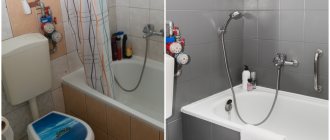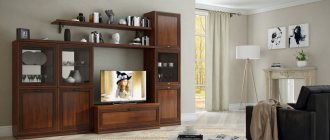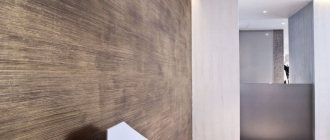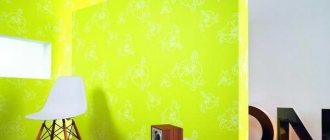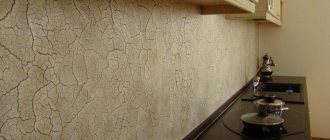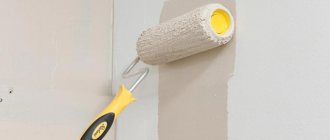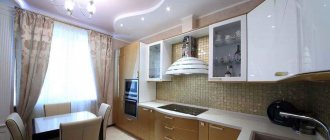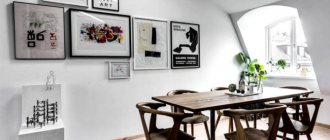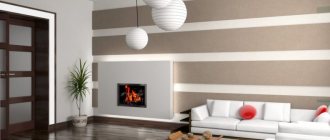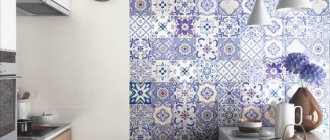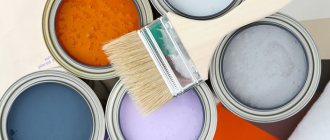The kitchen is very different from all other rooms in the house or apartment. Here they not only cook food, but also organize family gatherings or receive guests. We can say that the kitchen is the heart of the whole home. That is why it should look beautiful and neat, and always be clean.
Kitchen walls have one unpleasant feature - they get dirty very quickly.
When choosing to paint the walls, you can realize all your design fantasies, make the room bright and light, but at the same time cozy. A huge advantage for housewives will be the simplicity and ease of cleaning. Painted surfaces are easy to clean - just wipe the stain with a sponge and a drop of detergent.
Every housewife dreams of easy cleaning of kitchen surfaces, and washable paint for kitchen walls will help her with this, since it can be easily cleaned with wet cleaning.
It is worth noting that the painted coating after drying comes in three types:
- glossy;
- matte;
- semi-gloss.
Washing paint is one of the most popular materials used in finishing kitchen walls.
Classification of paints
The paint and varnish material consists of a base, a pigment and a binder. The last component ensures adhesion of the composition to the wall and the pigment particles of the paint to each other. The base makes the mixture viscous and allows it to lie smoothly on the surface.
According to the type of finished coating, all paints are divided into matte, glossy and semi-gloss. Glossy ones are more suitable for the kitchen because they are easy to clean.
The following types of paint and varnish coatings are used for finishing kitchen walls:
- water-based;
- alkyd;
- silicone;
- epoxy;
- acrylic.
Let's look at the detailed characteristics of each type, how they differ from each other, and which paint is best suited for finishing the kitchen.
Water-based
Water emulsion has a number of advantages. During painting, you do not need to leave the room due to the strong smell. Water-based materials dry quickly - usually no more than 2-4 hours. The paint is suitable for any surface - be it walls made of concrete, plasterboard, wood. The color palette is extensive; to obtain the desired color, simply add the desired color.
Important! Beware of fakes. There are more and more fake water-based emulsions on the market every day. Such materials do not fit well on walls, are quickly consumed and take a long time to dry. To avoid mistakes, purchase goods in specialized stores.
Alkyd
Alkyd paints come in water-based and varnish types. They can even be applied to metal and stone. They create a harder, but less elastic film compared to oil analogues. They are resistant to moisture and chemicals, which is important for the kitchen. Such walls can always be washed without worrying about their appearance. Among the disadvantages, it is worth noting the pungent odor when painting and the short service life - after a few years, alkyd paints fade.
Silicone
The material is based on silicone resin. It not only gives the surface a rich color, but also masks small cracks. The paint is more expensive than most analogues, but it is highly resistant to moisture, which is especially important for the kitchen. In addition, silicone materials prevent the appearance of mildew and mildew.
Epoxy
Epoxy paints are made from resins. These components form a durable coating layer on the walls. In the kitchen, it is better to use two-component epoxy paint for concrete, as it is economical in consumption and easy to use. In addition, the color range of epoxy paints is very extensive.
This type of paint creates a variety of effects: matte, glossy, textured. Epoxy paint is an excellent alternative to ceramic tiles: it also contains no hazardous substances, but it is cheaper than tiles. In addition, you can paint the walls yourself, but it is better to entrust the work with tiles to a professional.
The material is durable and less susceptible to external factors. The paint is resistant to moisture, making it excellent for painting walls in the kitchen. The drying time ranges from 12 to 24 hours - depending on the air temperature. It is also resistant to ultraviolet rays.
Acrylic
Based on their composition, they are divided into two types: synthetic and organic. It all depends on the coloring pigments: in some materials they are of natural origin, in others they are artificial. Organics give soft pastel colors, and artificial compounds make the color of the walls bright and rich. The advantages of acrylic surfaces include resistance to high temperatures, quick drying, and a variety of colors. In addition, the paint meets all fire safety requirements.
How to paint the walls in the kitchen so that they can be washed? Glossy acrylic paint is suitable for this. This is a win-win option for keeping your kitchen clean. The paint contains resin, so dirt remains on the surface and the walls are easily washed. The glossy effect visually expands the space, which is especially important for small kitchen spaces. The only drawback of acrylic coatings is the high cost of the material.
Color solution
When choosing what color to paint your kitchen, you should proceed from your own preferences. However, when creating the design of this room with your own hands, it is worth listening to the opinions of experts who say:
- The color red stimulates appetite and can provoke quarrels between family members.
- Yellow lifts your spirits and puts you in an optimistic mood.
- Orange promotes idea generation and creative development.
- Blue color is ideal for people who are on a diet. It also helps to harmonize internal energy and calms.
- Chocolate color and all shades of beige symbolize coziness, warmth and comfort. Therefore, it is worth using it to strengthen family ties and traditions.
- Lilac and violet promote the development of intuition and creativity, so the dishes in such a kitchen will be varied, refined and original.
- White color is ideal for the kitchen. It doesn’t matter whether the washable surface of the walls is matte or glossy. However, the design of the room should contain bright, contrasting accessories that will dilute the monotony. The fact is that the abundance of white color negatively affects a person’s vision and does not allow complete relaxation. To avoid this, you can paint the kitchen facades in a more contrasting color.
The abundance of paints for the walls in the kitchen helps to create an interior that meets all the owners’ requests regarding color and quality of the material. Ease of application allows you not to involve professionals in the work, but to do everything yourself. This will help save not only material resources, but also your nerves.
Advantages of using modern paints
Every year, manufacturers offer more and more paints that have significant advantages over other coatings. This is explained by the following factors:
- Painting walls is easy, because it does not require special knowledge or the involvement of a specialist. Of course, if we are not talking about complex coloring.
- The paint is affordable.
- The walls are easy to clean.
- When defects appear, they are removed fairly quickly. To do this, you just need to apply another layer of paint to the walls.
- Choosing paint to match your kitchen interior is much easier than choosing wallpaper.
- The color palette will satisfy the desires of any consumer.
Design Tips
Recommendations from professional decorators are mostly aimed at choosing colors and reflective properties of the composition. For spacious kitchens, you can use both light and dark paints. The main requirement is the presence of 2-3 primary colors. Plain kitchens look very boring or even gloomy, especially if we are talking about a room with a significant area.
To make the room more respectable, the tone of the flooring is made darker. The ceiling is usually painted white. It is not necessary to use a snowy shade. Ceilings painted in ivory, ivory, champagne, pearl, milky and creamy tones look very good. For spacious kitchens, designers recommend using a matte design. Soft light-absorbing surfaces will make such a room more comfortable, especially if the room's windows face south or east.
Small kitchens are best painted in light neutral colors. It can be white, beige, pink, blue, light green. The glossy texture helps to visually increase the space. If the windows of a small kitchen face the north side, shiny surfaces will “successfully” catch the meager rays of the sun and enhance them due to their reflective properties. A small kitchen can also be finished in matte colors. At the same time, it is important to maintain balance by diluting the interior with several fairly bright splashes.
If you plan to paint the walls with various patterns or ornaments, it is better to use a matte coating as a base. Possible flaws will be less noticeable on it.
Disadvantages of painting walls
Despite the advantages, painting walls has some disadvantages:
- Unlike wallpaper, paint does not hide wall unevenness, for example, roughness, small potholes, scratches.
- Some types cannot withstand strong mechanical stress, which is why the surface begins to burst.
- Sometimes the paint takes several days to dry, and a pungent odor spreads throughout the room.
Caring for painted surfaces
Painted walls can last 5 years or longer if you follow the manufacturer's recommendations. It is important to consider the following rules regarding the use of applied paint:
- silicone coloring solutions do not tolerate exposure to chemical reagents, especially alkalis;
- After painting with acrylic compounds, the surface can only be washed with soft, damp cloths or napkins. You can moisten a sponge or rag in a solution of ordinary laundry soap or delicate washing powder;
- It is better not to use abrasive substances and pastes for washing. However, water-based solutions, after drying, can withstand the effects of abrasive detergents, but during washing it is important to ensure that abrasions and other defects do not appear;
- Kitchen walls painted with latex substances have very high chemical resistance, so they can be cleaned with any detergent, but caution and accuracy will not hurt.
If mechanical damage occurs, you can use a colorless sealant for minor repairs.
Criteria for choosing paint for the kitchen
When choosing materials for the kitchen, you should pay attention to:
- Lifespan of paint. Silicone or latex have the best performance. They create a durable surface, but are more expensive. After drying, they form a thin film, which additionally protects them from abrasion.
- Drying times. Water-based materials are recognized as leaders in this area. They also do not have an unpleasant odor. They are very convenient to work with, and you only need to dilute them with water. When using water-based paint, you should not be afraid to get your hands or tools dirty; they will wash off without much effort.
- Resistant to external factors such as moisture, dirt, grease. Washable kitchen paint is a win-win option for practical people.
- Environmental friendliness. Despite the fact that today most materials do not contain components harmful to human health, it is still necessary to carefully read the information about the composition.
Important! Sometimes it is worth choosing the most expensive paints because they have the best characteristics. The brands Teknos, Dufa, and Marshall are recognized as the leaders in paints for kitchen walls.
Let's sum it up
As you can see, the list of advantages of kitchen paints is undeniably wider than the list of disadvantages. Moreover, the latter are very conditional and are decided by the right choice. However, it is necessary to understand that each type of paint has its own characteristics, pleasant and not so pleasant. In addition, everyone has their own preferences and something that may seem like a disadvantage to someone may be the main reason for purchasing for another.
You should only buy paints in large stores that value their reputation. In small shops or markets, there is a very high probability of purchasing a fake, which is unlikely to please you with its quality.
Advice! When purchasing, check the tightness of the packaging and pay attention to the structure of the paint itself: the thickness may vary depending on the type and manufacturer, but the mass should be smooth, homogeneous, without foreign elements.
When choosing paint, you should rely not only on your beliefs, but also pay attention to the preferences of your family. After all, the mood of family breakfasts and dinners depends on the color of the kitchen walls.
Wall painting technology
During painting you will need:
- putty knife;
- wide and narrow brushes;
- paint bucket;
- a tool for stirring paint (an ordinary wooden stick will do);
- sandpaper;
- scraper.
Wall preparation consists of the following steps:
- Cover floors, furniture and windows with plastic sheeting. This will protect the room from contamination.
- Prepare the walls, they should be clean and dry. Make sure that there are no traces of grease, dirt or dust left on them. If the wall is new, it needs to be primed; if not, you should evaluate the condition of the old paint. If the old paint on the wall is peeling and crumbling, remove it. If the surface is in good condition, simply wash it and wipe it dry.
- Check the walls for mold and mildew. If you find them, you should apply an antifungal agent. Then dry the surface thoroughly.
- All cracks and scratches on the walls must be puttied and treated with sandpaper, then the surface must be vacuumed and primed. The result is a homogeneous wall without unevenness.
Important! If the walls are covered with wallpaper, you need to remove them after wetting them with water. You can also use a special liquid to remove old wallpaper. This will help remove any remaining old glue.
Paint preparation:
- Stir the paint thoroughly. This can be done conveniently using a wooden stick or an electric drill.
- If necessary, thin the paint with water.
- Pour a small amount into a paint bucket.
During the painting process, the room temperature should be no lower than 5 degrees, air humidity – no more than 80%. The manufacturer always indicates on the packaging how many layers need to be applied to the wall. They also write down data on drying time and material consumption. Painting walls always starts from the corners. Round rollers are best for this.
To obtain a rich shade, apply 2 or 3 layers of paint. The first will distribute the paint over the surface, the subsequent ones will mask unevenness and even out the color. The optimal time for coloring is during the day. If the kitchen is located on the south side, then it is better to paint it in the morning or evening so that the sun's rays do not hit the walls.
Important! Good wall coverage is achieved by alternating vertical and horizontal strokes. The wall near the outlets should be painted with a small brush, and near the window frames - with a round roller or flat brush.
What tools to use
First, let's figure out how to paint the kitchen. To do this you need the following tools:
- Brushes;
- Painting film;
- Wide and narrow paper tape;
- Narrow and wide spatula;
- The scrapers are triangular and have a cutout for a roller;
- Plastic bucket;
- Tray or grid corresponding to the roller;
- Rollers (large, small, narrow);
- Bar for mixing paint;
- Sandpaper, mesh and pen, tool for sanding walls;
- Silicone gun:
- Drill with mixer for putty.
- Level (to check the evenness of the walls)
Painting tools
The width of the rollers should be from 20 to 32 cm, the length of the pile should be from 8 to 12 mm. A foam roller is not for you. For hard-to-reach areas you need a radiator roller.
You need two brushes. One is 50 cm wide, the other is 35 cm. For large areas you need a 75 cm brush. For water-based paints we take nylon brushes, for alkyd ones - with natural bristles. You will also need a curved battery brush.
You can check the paint color on a piece of paper
To choose a paint, try coating the paper first, wait until it dries, and judge the color. The paint composition and putty must be from the same company. This determines how quickly the wall dries, how resistant it will be to mechanical damage, and its appearance.
How to paint the walls in the kitchen in an original way using a stencil
The stencil method is an excellent opportunity to decorate walls in an original way and without much effort. There are stencils of any design and varying complexity, for example, with the contours of animals, flowers, geometric patterns, waves and so on. Let's look at how to paint a wall correctly, using a flower stencil as an example.
Prepare a brush, masking tape, stencil and paint of two shades. For this painting technology, it is recommended to use water-based paints because they are resistant to moisture and heat, and they can also be washed. Use a wide brush or roller to create a uniform surface. For example, blue. Wait for the wall to dry.
Attach the stencil to the wall with masking tape. After this, pick up white paint with a brush and apply through the stencil. When the pattern is dry, peel off the template and attach it to a new location, repeating the steps described above. This is a very simple, but at the same time effective way to create a unique design.
